|
Having trouble reading this email? Download the PDF. 
Thematic focus: Environmental governance, Resource efficiencyWealth in the Oceans: Deep sea mining on the horizon?
The deep ocean, the largest biome on Earth at over 1 000 metres below the surface of the ocean, holds vast quantities of untapped energy resources, precious metals and minerals. Advancements in technology have enabled greater access to these treasures. As a result, deep sea mining is becoming increasingly possible. To date no commercial deep sea mining operation has taken place, but plans to open a deep sea mine have recently been announced. Our ability to anticipate the impacts of mining is limited by the lack of knowledge about deep sea biodiversity, ecosystem complexity, and the extent of environmental and social impacts from mining operations. As such, it is important that policies guiding mineral extraction from the deep seas are rooted into adaptive management—allowing for the integration of new scientific information alongside advances in technology. Governance mechanisms for international waters and the seabed need to be strengthened. The precautionary approach should be used to avoid repeating instances of well-known destructive practices associated with conventional mining. Why is this issue important?Minerals and the metals they contain are an essential component of the modern high-tech world. As global stocks of raw mineral resources continue to dwindle due to increasing material consumption, intense demand for valuable metals has pushed up global prices. The result is that manufacturing industries are now seeking access to previously unattainable mineral deposits in the ocean depths. The deep ocean is predicted to hold large quantities of untapped energy resources, precious metals and minerals (Ramirez-Llodra et al., 2010) including three types of potentially economically viable mineral resources: sea-floor massive sulphides (SMS), cobalt-rich ferromanganese crusts, and polymetallic (manganese) nodules (Figure 1). Deep sea mining is appealing to many countries, including Small Island Developing States, as a means of economic development and revenue generation. In April 2014, Nautilus Minerals, a Canadian company, and the Independent State of Papua New Guinea signed an agreement to begin the world's first deep sea mining for ores of copper, gold, and other valuable metals (Nautilus Minerals, 2014). Mining companies, and national governments, have leases to explore margin sediments for phosphates off Namibia, New Zealand, and Mexico (Mengerink et al., 2014). Some of the contracts are further summarised in Table 1 (ISA, 2014b).
What are the findings?Between 2000 and 2010, the price of many non-energy raw materials increased annually by about 15%, mainly as a result of consumer demand in emerging economies (WTO, 2010). Advances in technology as well as concerns over security of supply have encouraged mining companies to consider what the seabed can provide. By 2020, 5% of the world's minerals, including cobalt, copper and zinc could come from the ocean floors. This could rise to 10% by 2030. Global annual turnover of marine mineral mining can be expected to grow from virtually nothing to €5 billion in the next 10 years and up to €10 billion by 2030 (EC, 2012).
Sea-floor massive sulphides deposits are created by hydrothermal activity (photo above and Figure 2) when extremely hot fluids, in excess of 350°C, are released onto the sea-floor. They were first documented in 1977 and are now known to be present throughout the world's oceans in areas of tectonic activity. These deposits contain copper, lead, zinc, silver and gold, barium, nickel and other trace metals (Baker and German, 2009). While these deposits are mostly located within areas under national jurisdiction, there are deposits outside jurisdictional marine areas. Polymetallic (manganese) nodules are rocky lumps (Figure 3) that vary from between five and ten centimetres in size. They form from iron and manganese hydroxides at water depths between 4 000 and 6 500 meters. The metals within—including nickel, copper, and lithium, among others—hold commercial value for many technological applications. The most significant known concentration of these deposits is found in the Clarion Clipperton Zone of the equatorial Pacific (see Figure 4).
Cobalt-rich ferromanganese crusts are hard, solid layers up to 25 centimetres thick that form when manganese and iron precipitate out of cold seawater (Figure 5 and photo below). They may contain cobalt, nickel, and some rare earth elements and could provide up to 20% of the global cobalt demand (Ramirez-Llodra et al., 2010). These crusts are firmly adhered to the surfaces of seamounts, ridges, and plateaus at water depths of 400-7 000 metres. Initial licences issued by the International Seabed Authority are targeted at the flat tops of seamounts (guyots) in the western Pacific Ocean where thick cobalt crusts have been formed and where the geology is relatively 'benign' (ISA, 2013a; b).
Deep sea mining process Mineral extraction generally involves three basic processes that are common across each mineral type as shown in Figure 6 (Clark and Smith, 2013a; b). After separation of the mineral crusts from the sea-floor, the crusts are crushed and ground to dislodge the attached deposits. The disaggregated material or slurry is then lifted in a pumping mechanism through the water column to a processing vessel. Excess water is removed from the slurry and returned to the ocean. Environmental considerations Several impacts are common across the extraction of the three types of deposits (Clark and Smith, 2013a, b). Impacts associated with the presence of marine vessels primarily occur at the surface. These impacts include the inadvertent introduction of invasive species, noise and air pollution generated by ships, fluid leaks and discharges from vessels and equipment, and vibrations. More specific to mining is the introduction of light into sea floor environments that are normally light-deprived. Light may attract or deter some fish species, and may alter normal feeding and reproduction behaviours. Impacts to the water column occur when the mined material is lifted from the sea floor to the mining vessel at surface level, when the ore is dewatered and as a result of routine discharges and spills from the vessel. Dewatering of the slurry in the water column (versus as near to the sea floor as possible) may have a clouding effect, resulting in localised impacts on primary productivity and potentially reducing oxygen levels. In addition, the released seawater will be different in composition from when it was collected with the ore and is likely to contain different levels of salinity, temperature and trace amounts of toxic chemicals. Ingestion of the contaminated water by organisms may create a potential for bioaccumulation through the food chain (Coffey, 2008). Species found in active hydrothermal vent sites where sea floor massive sulphides deposits occur, include vent-endemic organisms such as barnacles, snails, mussels, crabs, tubeworms, shrimps, and various fish (German et al., 2011). Because these communities are localised, even small-scale mining activities can wipe out vent communities (Van Dover, 2011a). Studies show that some species may possess the ability to re-colonise quickly following an event that is detrimental to their habitat (Van Dover et al., 2011). However, species at dormant vent sites may take more than a 10-year period to re-colonise (Van Dover 2011b; Williams et al., 2010). Away from the vent sites there are other species that reside on the sea floor (Figure 7). These are often filter feeders, such as cold deep-water corals and sponges that rely on a clean current to supply their nutrients. During mining, sediments on the sea floor are disturbed and the presence of particulate matter can alter food supply. Large amounts of disturbed sediment can also have a smothering effect on certain sea floor residents. Mining manganese nodules is expected to occur over large areas. In the process all living organisms on the sea floor, and perhaps to some depth below the surface in the mine area, could be destroyed (Figure 6b). The increased turbidity from very fine sediments may adversely impact the surrounding fauna which may be poorly adapted to cope with disturbance (Stoyanova, 2012; Zhou, 2007). Experiments carried out in both the Peru basin and the Clarion Clipperton Zone (see Figure 4) show that even though mobile species may return after disturbance, sessile species do not recover (Kaneko et al., 1997; ISA, 1999; Thiel et al., 2001; Bluhm, 2001).
Many seamounts, where cobalt-rich ferromanganese crusts occur, have been impacted already by bottom trawling. It is evident from impact studies on fishing activities that seamount biota are particularly sensitive to human disturbances (Koslow et al., 2001; Clark and Tittensor, 2010). Recovery may take decades to centuries as revealed by site tests in the offshore areas of New Zealand and Australia (Williams et al., 2010). The history of Pacific Island states' experiences with terrestrial mining suggests that impacts related to pollution and environmental amenities will be especially important to prioritize. This may include concerns linked to usage of coastlines (such as ports, transport or mooring of mining-related ships and equipment) disposal of waste and any deep sea pollution or disturbance. However, current proposals for sea floor mining in the Pacific region appear to involve little or no onshore presence, and so the direct impacts may well differ from those that have been seen with terrestrial mining projects (Bice, 2011). Socio-economic considerations Predicting the impacts of mining on society is a complicated task that will differ from site to site (Vanclay and Esteves, 2011). The presence of mining vessels will necessitate site closures before, during, and potentially after mining activities. Such restrictions may extend beyond the mining site to the shipping routes. This may displace or disrupt fisheries and impact local livelihoods. Deep sea mining industry will need to address issues of self-determination amidst a growing public awareness of rights. This can be achieved partly through effective and comprehensive implementation of social licenses to operate and free, prior, and informed consent approaches (Nish and Bice, 2012). Governance in the deep ocean is fragmented. Although the water column and the seabed below 200 metres are interconnected, they are managed on a single-sector basis (Mengerink et al., 2014). The 1982 United Nations Convention on the Law of the Sea (UNCLOS) is an umbrella framework for international ocean management. Multilateral regional fishery management organisations regulate commercial fisheries harvest; the International Maritime Organization manages shipping; and the International Seabed Authority regulates mining of the international seabed. Management of other activities such as dumping, laying submarine cables and military activities that affect the deep ocean is similarly a single-sector approach. In some arenas, like marine genetic resource management, agreements and institutions are substantially lacking. It is important to realise that deep sea mining activities need to be analysed in relation to their location and other surrounding uses that are in close proximity as such multiple actions often contribute to cumulative impacts on the environment. What are the implications for policy?Countries in the Pacific region recognised the new opportunities related to offshore minerals as early as 1999 (SOPAC, 1999) where they committed to a regulatory approach to deep sea minerals. The regulatory scope has since been expanded in the SPC-EU Deep Sea Minerals Project's Pacific Islands Regional Legislative and Regulatory Framework (SPC, 2012) and is now being implemented through the development of world-leading national statutory regimes encompassing fiscal, social, and environmental governance. Such governance is essential to ensure that deep sea mining meets development objectives and provides a stable and transparent climate for investment as shown on Table 2 (Franks, 2012).
As part of a green economic approach, five policy design principles could be considered when evaluating potential development (Daly and Farley, 2011). These principles are approaches to representing, monitoring, and accounting for global needs and local goals, while ensuring the integrity and health of priceless natural systems. 1. Economic policy does not involve one goal but many. Each desired goal (for example, poverty reduction and increased resource efficiency) must be addressed, sometimes by its own policy instrument and always in a coordinated way. For instance, a royalty system—developed to promote economically efficient use—would be coordinated with an income distribution system that would help to alleviate poverty. 2. Because of the cumulative impacts of mining, policies should aim to establish the necessary degree of "big picture control", while maintaining critical flexibility to accommodate the need for activity-specific variability. At the national scale, the limiting consideration is cost, in terms of lost ecosystem function and services. This consideration would drive the development of a national policy instrument to limit total habitat impact or loss of ecosystem value, by considering all mining activities in the country, possibly together with all major activities that affect habitat quality and ecosystem value. 3. Policies should be developed with a generous margin of error when dealing with the biophysical environment. Operating near or at system capacity can lead to unexpected and unaffordable costs. Mining development should be designed to avoid areas of critical biological and ecosystem importance, minimise environmental impacts at every stage, and mitigate unavoidable environmental damage. 4. Policies should recognize that the starting point is always based on the current policy-making reality, and should build on existing good environmental and social policies that are effective. Developing policy instruments focused on potential deep sea mining will require reshaping and transforming existing policy processes, regulations, economic frameworks and/or institutions so that they are more effective for investments needed. 5. Policies should be adaptable to conditions and parameters that are likely to change. As society comes to terms with the challenges and opportunities of a reality defined by increasingly scarce natural resources, policy for the management of emerging unconventional resources such as deep sea minerals will need to adapt to rapidly changing social and ecological conditions and be responsive to long-term goals defined by factors of ecological and social sustainability. In the face of threats of irreversible damage in the deep ocean, there is a need to take appropriate precaution while enabling use of living and non-living resources (Mengerink et al., 2014). Yet-to-be-discovered species, habitats and functions must be safeguarded while scientific understanding required for ecosystem-based management and mitigation techniques are developed. This calls for appropriate multisector protection of habitat that is ecologically, biologically, and scientifically important. For international waters and the seabed, the United Nations Convention on the Law of the Sea may consider implementing a new agreement for the conservation and sustainable use of marine biodiversity beyond national jurisdiction. Overcoming fragmented governance requires improved collaboration. Marine spatial planning approaches provide a template for deep sea management and will require formal procedures for improved information-sharing and governance among stakeholders. This bulletin is based in part on work done for the following projects: (1) UNEP Green Economy in a Blue World (2012). http://www.grida.no/publications/green-economy-blue-world/ (2) SPC/SOPAC Pacific Deep Sea Minerals Assessment (2013) http://www.grida.no/publications/deep-sea-minerals/ and (3) European Commission study: Investigating the State of the Knowledge of Deep Sea Mining (2014) http://ec.europa.eu/dgs/maritimeaffairs_fisheries/consultations/seabed-mining/index_en.htm, http://eu-midas.net/, http://cordis.europa.eu/projects/rcn/111346_en.html AcknowledgementWriters: Yannick Beaudoina, Allison Bredbennera, Elaine Bakerb,
Charles Rochec, Sara Biced, Linwood Pendletone
ReferencesBaker, C., German, R., 2009. Going for gold! Who will win in the race to exploit ores from the deep sea? Ocean Challenge 16, 10-17. Bice, S., 2011. Beyond the business case: A new institutional analysis of corporate social responsibility in Australian mining. University of Melbourne, School of Social and Political Sciences. Bluhm, H., 2001. Re-establishment of an abyssal megabenthic community after experimental physical disturbance of the sea floor. Deep Sea Research 48, 3841-3868. Clark, M., Tittensor, D., 2010. An index to assess the risk to stony corals from bottom trawling on seamounts. Marine Ecology 31, 200-211 Clark, M., Smith, S., 2013a. Chapter 3.0: Environmental Management Considerations, in: Baker, E., Beaudoin, Y., (Eds.), Deep Sea Minerals: Sea-floor massive sulphides, a physical, biological, environmental, and technical review. Volume 1A, Secretariat of the Pacific Community. Clark, M., Smith, S., 2013b. Chapter 3.0: Environmental Management Considerations, in: Baker, E., Beaudoin, Y., (Eds.), Deep Sea Minerals: Manganese Nodules, a physical, biological, environmental, and technical review. Volume 1B, Secretariat of the Pacific Community. Coffey, 2008. Environmental Impact Statement: Solwara 1 Project. Nautilus Minerals Niugini Limited, http://www.cares.nautilusminerals.com/Downloads.aspx (accessed 12.04.14). Daly, H.E., Farley, J., 2011. Ecological economics: Principles and applications. Island Press, Washington, DC. EC, 2012. European Commission. Communication from the Commission to the European Parliament, the Council, the European Economic and social Committee and the Committee of the Regions: Blue Growth—opportunities from the marine and maritime sustainable growth. COM(2012) 494. http://eur-lex.europa.eu/LexUriServ/LexUriServ.do?uri=COM:2012:0494:FIN:EN:PDF(accessed 26.05.14). Franks, D., 2012. Social impact assessment of resource projects. International Mining for Development Centre. http://im4dc.org/wp-content/uploads/2012/01/UWA_1698_Paper-02_Social-impact-assessment-of-resource-projects1.pdf (accessed 20.03.14). German, C., Ramirez-Llodra, E., Baker, M., Tyler, P., Ch Ess Scientific Steering Committee, 2011. Deep-water chemosynthetic ecosystem research during the Census of Marine Life decade and beyond: a proposed deep-ocean road map. PlOS One 6(8), e23259. Hein, J., Mizell, K., Koschinsky, A., Conrad T., 2013. Deep-ocean mineral deposits as a source of critical metals for high- and green-technology applications: comparison with land-based resources. Ore Geology Review 51, 1-14. ISA, 1999. Deep-seabed polymetallic nodule exploration: Development of environmental guidelines, International Seabed Authority, Kingston, Jamaica. ISA, 2013a. http://www.isa.org.jm/files/documents/EN/Pubs/TS10/TS10-Final.pdfrelating to an application for the approval of a plan of work for exploration for cobalt-rich ferromanganese crusts by China Ocean Mineral Resources Research and Development Association. ISBA/19/C/2 http://www.isa.org.jm/files/documents/EN/19Sess/Council/ISBA-19C-2.pdf (accessed 20.03.14). ISA, 2013b. Report and recommendations of the Legal and Technical Commission to the Council of the International Seabed Authority relating to an application for the approval of a plan of work for exploration for cobalt-rich ferromanganese crusts by Japan Oil, Gas and Metals National Corporation ISBA/19/C/3. http://www.isa.org.jm/files/documents/EN/19Sess/Council/ISBA-19C-3.pdf (accessed 20.03.14). ISA, 2014a. International Seabed Authority Web GIS Application. International Seabed Authority (ISA), Kingston, Jamaica. http://www.mapserver.isa.org.jm/GIS/ (accessed 21.05.14). ISA, 2014b. Status of contracts for exploration for polymetallic nodules, polymetallic sulphides and cobalt-rich ferromanganese crusts. International Seabed Authority, Kingston, Jamaica. http://www.isa.org.jm/en/scientific/exploration/contractors (accessed 21.05.14). Kaneko, T., Maejima, Y. and Teishima, H., 1997. The abundance and vertical distribution of abyssal benthic fauna in the Japan Deep-Sea I mpact Experiment. The Seventh International Offshore and Polar Engineering Conference, 25-30 May, Honolulu, Hawaii, USA. Koslow, J., Gowlett-Holmes. K., Lowry. J., O'Hara. T., Poore, G., Williams, A., 2001. Seamount benthic macrofauna off southern Tasmania: community structure and impacts of trawling. Marine Ecology-Progress Series. 213, 111-125. Mengerink, K., Van Dover, C., Ardron, J., Baker, M., Elva Escobar-Briones, E., Gjerde, K., Koslow, J., Ramirez-Llodra, E., Lara-Lopez, A., Squires, D., Sutton, T., Andrew K. Sweetman, A., Levin L., 2014. A Call for Deep-Ocean Stewardship. Science 344, 696-698. Nautilus Minerals, 2014. Nautilus Minerals and State of PNG Resolve Issues and Sign Agreement. News Release, April 14, 2014. http://www.nautilusminerals.com/s/Media-NewsReleases.asp?DateRange=2014/01/01...2014/12/31 (accessed 26.05.14). Nish, S., and Bice, S., 2012. Community based agreement-making with land connected peoples, in: Vanclay, F., Esteves, A. (Eds.), New directions in social impact assessment: Conceptual and methodological advances. Edward Elgar Publishing, Cheltenham, UK, pp. 59-78. Ramirez-Llodra, E., Brandt, A., Danovaro, R., De Mol, B., Escobar, E., German, C. R., Levin, L., Martinez Arbizu, P., Menot, L., Buhl-Mortensen, P., Narayanaswamy, B., Smith, C., Tittensor, D., Tyler, P., Vanreusel, A., and Vecchione, M., 2010. Deep, diverse and definitely different: unique attributes of the world's largest ecosystem. Biogeosciences 7, 2851-2899. SOPAC, 1999. The Madang guidelines: Principles for the development of national offshore mineral policies. South Pacific Applied Geoscience Commission, Secretariat of the Pacific Community. http://ict.sopac.org/VirLib/MR0362.pdf (accessed 20.3.14). SPC, 2012. Pacific-ACP states regional legislative and regulatory framework for deep sea minerals exploration and exploitation. Secretariat of the Pacific Community, Suva, Fiji. http://www.smenet.org/docs/public/FinalDeepSeaMineralsProjectReport.pdf (accessed 20.03.14). Stoyanova, V., 2012. Megafaunal diversity associated with deep-sea nodule-bearing habitats in the eastern part of the Clarion-Clipperton Zone, NE Pacific. 12th International Multidisciplinary Scientific GeoConference, SGEM2012, Conference Proceedings Vol. 1. Thiel, H., Schriever, G., Ahnert, A., Bluhm, H., Borowski, C., Vopel, K., 2001. The large-scale environmental impact experiment DISCOL— reflection and foresight. Deep Sea Research Part II: Topic Studies in Oceanography 48, 3869-3882. Vanclay, F., Esteves, A., 2011. Current issues and trends in social impact assessment, in: Vanclay, F., Steves, A. (Eds.), New directions in social impact assessment: Conceptual and methodological advances. Edward Elgar Publishing, Cheltenham, UK. pp. 3-19. Van Dover, C., 2011a. Tighten regulations on deep-sea mining. Nature 470, 31-33. Van Dover, C., 2011b. Mining seafloor massive sulphides and biodiversity: what is at risk? ICES J. Mar. Sci. 68, 341-348. Van Dover, C. , Smith, C., Ardron, J., Arnaud-Haond, S., Beaudoin, Y., Bezaury, J., Boland, G., Billett, D., Carr, M., Cherkashov, G., Cook, A., DeLeo, F., Dunn, D., Fisher, C.R., Godet, L., Gjerde, K., Halpin, P., Levin, L., Lodge, M., Menot, L., Miller, K., Milton, D., Naudts, L., Nugent, C., Pendleton, L., Plouviez, S., Rowden, A., Santos, R.S., Shank, T., Smith, S., Tao, C., Tawake, A., Thurnherr, A., and Treude, T., 2011. Environmental management of deep Sea chemosynthetic ecosystems: justification of and considerations for a spatially-based approach. ISA Technical study No. 9. International Seabed Authority, Kingston, Jamaica, 90pp. http://www.isa.org.jm/files/documents/EN/Pubs/TS9/index.html (accessed 23.05.14) Williams, A., Schlacher, T., Rowden, A., Althaus, F., Clark, M., Bowden, D., Stewart, R., Bax, N., Consalvey, M. Kloser, R., 2010. Seamount megabenthic assemblages fail to recover from trawling impacts. Marine Ecology 31, 183-199. WTO, 2010. Trade growth to ease in 2011 but despite 2010 record surge, crisis hangover persists, PRESS/628, 7 April 2011. http://www.wto.org/english/news_e/pres11_e/pr628_e.htm (accessed 26.05.14) Zhou, H., 2007. The chemical environment of cobalt-rich ferromanganese crust deposits, the potential impact of exploration and mining on this environment, and data required to establish environmental baselines in the exploration areas, in: ISA (Ed.), Polymetallic sulphides and cobalt rich ferromanganese crust deposits: establishment of environmental baselines and an associated monitoring programme during exploration, Proceedings of the International Seabed Authority's workshop, Kingston, Jamaica, 6-10 September 2004, 257-267. http://www.grida.no/files/publications/ebooks/deepsea/vol1C/index.html#40 (accessed 21.03.14) If you no longer wish to receive this bulletin you can unsubscribe anytime. Information is regularly scanned, screened, filtered, carefully edited, and published for educational purposes. UNEP does not accept any liability or responsibility for the accuracy, completeness, or any other quality of information and data published or linked to the site. Please read our privacy policy and disclaimer for further information. |
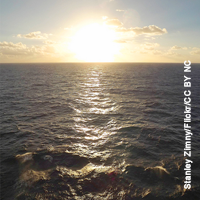
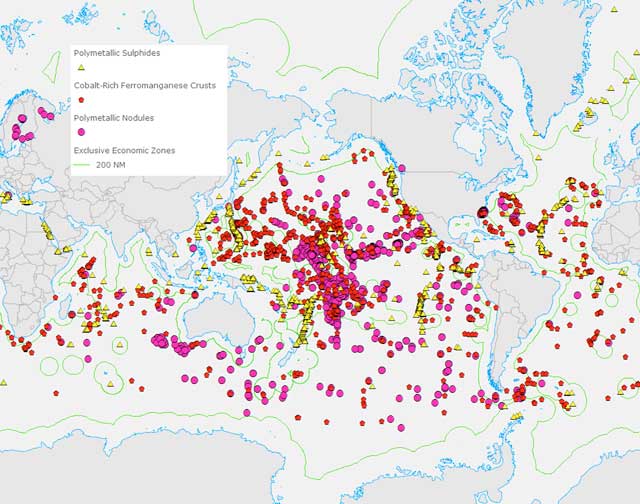 Figure 1: Global distribution of three major types of deep sea mineral resources (UNEP/DEWA adapted from ISA, 2014a).
Figure 1: Global distribution of three major types of deep sea mineral resources (UNEP/DEWA adapted from ISA, 2014a).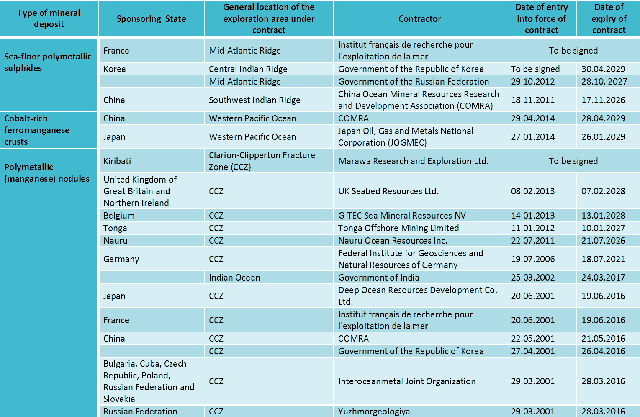 Table 1: Contracts for exploration of deep sea mineral deposits (Adapted from ISA, 2014b).
Table 1: Contracts for exploration of deep sea mineral deposits (Adapted from ISA, 2014b).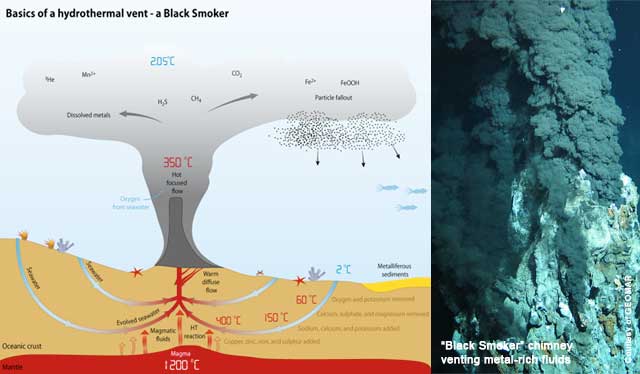 Figure 2: Basics of a hydrothermal vent (GRID-Arendal).
Figure 2: Basics of a hydrothermal vent (GRID-Arendal).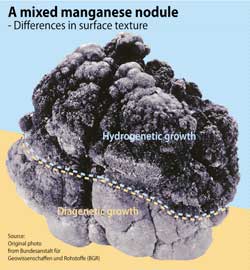 Figure 3: Picture and description of a manganese nodule recovered from the Clarion Clipperton Zone in the Pacific Ocean (Adapted by GRID-Arendal).
Figure 3: Picture and description of a manganese nodule recovered from the Clarion Clipperton Zone in the Pacific Ocean (Adapted by GRID-Arendal).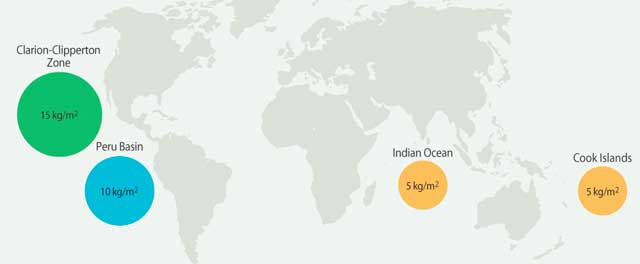 Figure 4: Average abundance of polymetallic (manganese) nodule in four major locations (GRID-Arendal adapted from Hein et al., 2013).
Figure 4: Average abundance of polymetallic (manganese) nodule in four major locations (GRID-Arendal adapted from Hein et al., 2013).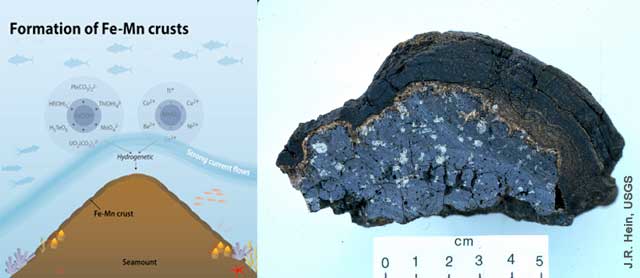 Figure 5:(Left) Formation of cobalt-rich ferromanganese crusts. (GRID-Arendal adapted from Hein et al., 2013). (Right) Ferromanganese crust on basalt
(photo by J.R. Hein, USGS, cruise L5-85-NC, D33-1, Gorda Ridge, NE Pacific).
Figure 5:(Left) Formation of cobalt-rich ferromanganese crusts. (GRID-Arendal adapted from Hein et al., 2013). (Right) Ferromanganese crust on basalt
(photo by J.R. Hein, USGS, cruise L5-85-NC, D33-1, Gorda Ridge, NE Pacific).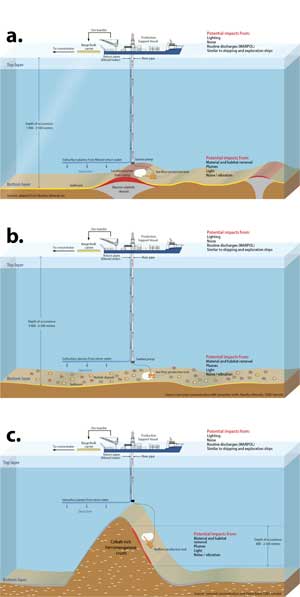 Figure 6: Schematic of deep sea mining of (a) sea floor massive sulphides (b) manganese nodules and (c) cobalt-rich ferromanganese crusts (GRID-Arendal).
Figure 6: Schematic of deep sea mining of (a) sea floor massive sulphides (b) manganese nodules and (c) cobalt-rich ferromanganese crusts (GRID-Arendal).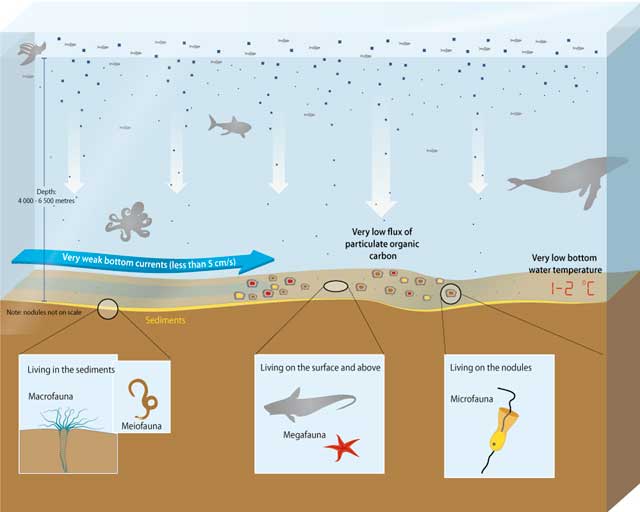 Figure 7: Schematic representation of habitats and biodiversity in areas where manganese nodules have been found (GRID-Arendal).
Figure 7: Schematic representation of habitats and biodiversity in areas where manganese nodules have been found (GRID-Arendal).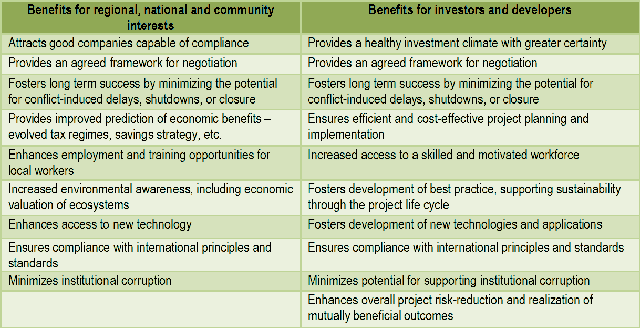 Table 2: Benefits of an effective regional deep sea mining policy regime (Franks, 2012)..
Table 2: Benefits of an effective regional deep sea mining policy regime (Franks, 2012)..